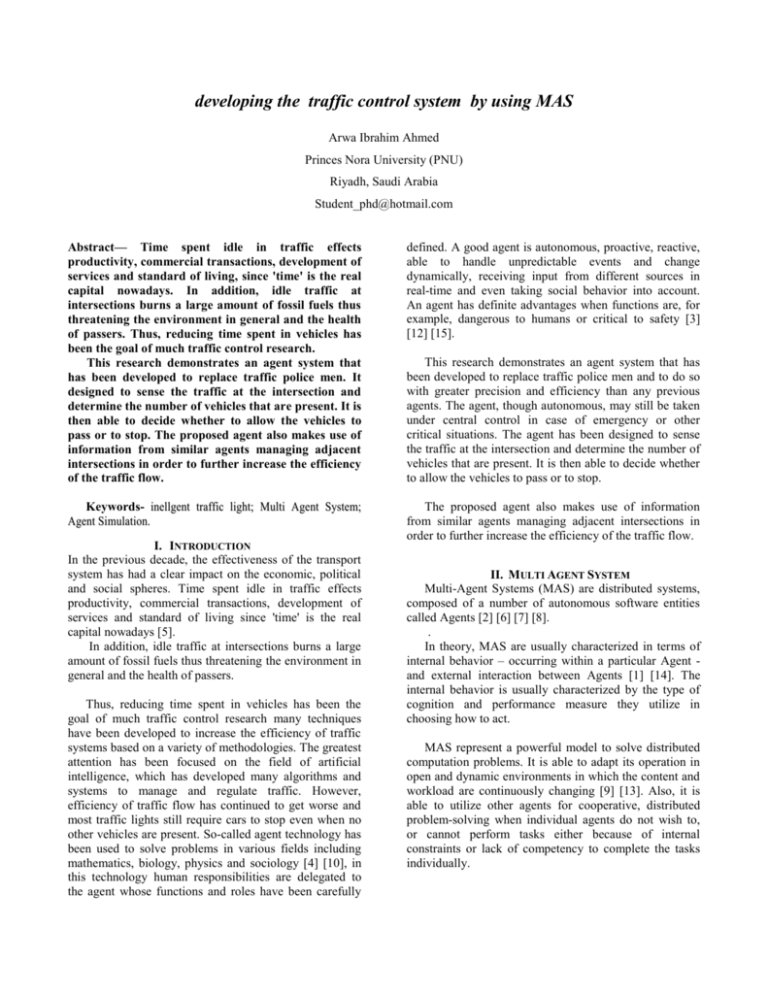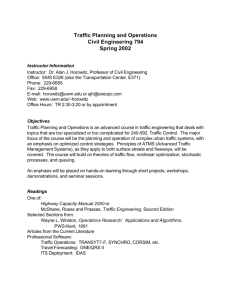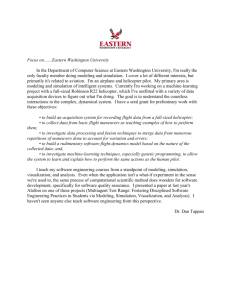developing-the-traffic-control-system
advertisement

developing the traffic control system by using MAS Arwa Ibrahim Ahmed Princes Nora University (PNU) Riyadh, Saudi Arabia Student_phd@hotmail.com Abstract— Time spent idle in traffic effects productivity, commercial transactions, development of services and standard of living, since 'time' is the real capital nowadays. In addition, idle traffic at intersections burns a large amount of fossil fuels thus threatening the environment in general and the health of passers. Thus, reducing time spent in vehicles has been the goal of much traffic control research. This research demonstrates an agent system that has been developed to replace traffic police men. It designed to sense the traffic at the intersection and determine the number of vehicles that are present. It is then able to decide whether to allow the vehicles to pass or to stop. The proposed agent also makes use of information from similar agents managing adjacent intersections in order to further increase the efficiency of the traffic flow. defined. A good agent is autonomous, proactive, reactive, able to handle unpredictable events and change dynamically, receiving input from different sources in real-time and even taking social behavior into account. An agent has definite advantages when functions are, for example, dangerous to humans or critical to safety [3] [12] [15]. Keywords- inellgent traffic light; Multi Agent System; A g e nt Si m ul a t i on. The proposed agent also makes use of information from similar agents managing adjacent intersections in order to further increase the efficiency of the traffic flow. I. INTRODUCTION In the previous decade, the effectiveness of the transport system has had a clear impact on the economic, political and social spheres. Time spent idle in traffic effects productivity, commercial transactions, development of services and standard of living since 'time' is the real capital nowadays [5]. In addition, idle traffic at intersections burns a large amount of fossil fuels thus threatening the environment in general and the health of passers. Thus, reducing time spent in vehicles has been the goal of much traffic control research many techniques have been developed to increase the efficiency of traffic systems based on a variety of methodologies. The greatest attention has been focused on the field of artificial intelligence, which has developed many algorithms and systems to manage and regulate traffic. However, efficiency of traffic flow has continued to get worse and most traffic lights still require cars to stop even when no other vehicles are present. So-called agent technology has been used to solve problems in various fields including mathematics, biology, physics and sociology [4] [10], in this technology human responsibilities are delegated to the agent whose functions and roles have been carefully This research demonstrates an agent system that has been developed to replace traffic police men and to do so with greater precision and efficiency than any previous agents. The agent, though autonomous, may still be taken under central control in case of emergency or other critical situations. The agent has been designed to sense the traffic at the intersection and determine the number of vehicles that are present. It is then able to decide whether to allow the vehicles to pass or to stop. II. MULTI AGENT SYSTEM Multi-Agent Systems (MAS) are distributed systems, composed of a number of autonomous software entities called Agents [2] [6] [7] [8]. . In theory, MAS are usually characterized in terms of internal behavior – occurring within a particular Agent and external interaction between Agents [1] [14]. The internal behavior is usually characterized by the type of cognition and performance measure they utilize in choosing how to act. MAS represent a powerful model to solve distributed computation problems. It is able to adapt its operation in open and dynamic environments in which the content and workload are continuously changing [9] [13]. Also, it is able to utilize other agents for cooperative, distributed problem-solving when individual agents do not wish to, or cannot perform tasks either because of internal constraints or lack of competency to complete the tasks individually. III. INTEGRATED TRAFFIC LIGHT SYSTEM WITH AGENT TECHNOLOGY Our model is based on an adaptive and cooperative multiagent system. The individual Agents are active rather than passive and are able to make independent decisions. The algorithm on which the multi-agent system runs has no pre-defined cycle time or default to green wave. The agents at each intersection make decisions on how to control their particular intersection based on the goal. To get the traffic information, there are a variety of possible detectors such as loop detectors, infra-red, magnetic, sonar, microwave radar and real time video sensor. The important thing is to collect information about the density of traffic in each direction as well as about the length of the queue (the numbers of vehicles that are present near the intersection). As long as the agents are properly coordinated and can negotiate with each other, an overall improvement of the traffic flow can be expected. IV. JUNCTION MANAGER AGENT (JMA) A junction manager agent has a perception of their local environment through sensors and can make dynamic adjustments. It takes information from sensors as well as neighboring agents to make the decision about the phasing of the traffic lights. Since every agent has a unique name they can be programmed to only send or receive messages to an agent from an adjacent intersection. Proactive behavior can help the agent to find the optimal traffic signal timing plans by running feasibility studies for various strategies. The study will evaluate the losses and profits for a time in each direction separately, and then give priority to the more crowded street, along with calculation of the impact on the amount of traffic for the nearby intersections. Using this information the intersection agent negotiates with its neighbors and comes to select an action from those available to it. To what degree an agent cooperates, coordinates and negotiates with other agents depends on its own control strategy which is designed to produce the optimal behavior of the whole system. Action Sens e Multi agent System Figure1.system overview Operational Layer: This layer is responsible for the basic information that is needed to accomplish the required calculations. On the following page the layers are shown as a diagram. Strategically Behavior Goals Decision maker Memory Perception Tactical Traffic parameter operational Operational Operation Control laws Figure3.system layers Execution Environm ent The domain of traffic and transportation systems is well suited agent-based approach because of its geographically distributed and dynamic changing nature. In particular, the proposed intelligent traffic agent system has many characteristics: Self-diagnostic; able to monitor the current state of the traffic including information about the capacity, the length of the queue and level of service in an intersection. Autonomous; able to plan by itself before acting, based on a programmed set of rules, and to continuously modify the action in its dynamic environment. Networked; not only using its own environment to make decisions but also communication and deliberation with other entities. Balanced; able to be both proactive and reactive depending on the objectives. Intentional; the system should be committed to achieving certain goals and should be able to create goals that can be achieved on the way to the overall goal. These requirements are all present in a system full of intelligent and autonomous agents. V. SYSTEM LAYERS ANALYSIS The intelligent traffic light system consists of three layers: Strategically Layer: The strategic layer represents the main goals of the system. Tactical Layer: The tactical layer describes the perception and reaction of the traffic light entity. This layer describes the behavior of the agent as well as all information and knowledge needed to make appropriate decisions. The decision making module is in this layer. VI. AGENT BASED SIMULATION: Agent-based modeling and simulation is a new approach and looks to have significant influence on traffic system simulations as it can include decision making in its simulation of intersection management. Already, some researchers have shown the effectiveness of this approach. Another of its advantages is the ability to cope with increasingly complex systems where the complexity is coming from the interdependence of elements in the system. Traditional simulation methods struggle with this and are unable to cope with anything too complex VII. INTELLIGENT TRAFFIC LIGHT SIMULATION: The biggest difficulties in this simulation were modeling the autonomous behavior of traffic lights, and simulating the traffic sufficiently so that the results were both reliable and realistic. Our solution is an integrated simulation platform for traffic lights, communication, and organization of intersections. This platform combines the capabilities supported by a network simulator and those supported by a traffic simulator. With these simulation capabilities, the model can be used to manage network intersections by intelligent behavior. This novel platform architecture allows us to get real-world application and means it is scalable. Careful focus was placed on the use of agents and the traffic signal control. Traffic lights were defined as intelligent agents that manage intersections. The algorithm was tested successfully under Net-logo. make a decision on action based on achieving the system objectives. This intelligent agent approach, built on a rulebased system aims to reduce each car’s delay at each junction. The model has ‘setup’ and ‘go’ buttons. The ‘setup’ button calls a procedure to reset the model to its initial state, and the ‘go’ button repeats a procedure that carries out all actions for each time step. A ‘step’ button can be added to perform only one run of the ‘go’ procedure, advancing the simulation by one time-step. Net Logo manages all visual aspects of the simulation, and automatically updates the visualization after every timestep. Below is a picture of what the system looks like after pressing the setup button and after press GO button, the system generates a random number of cars which can be seen in the next picture. Within the traffic environment any entity which has different behaviors under different conditions can be modeled as a separate agent. The individual agents are intelligent and autonomous in that they will sense their environment and act to fulfill its defined goals. Together the agents are represented by a Junction Manager Agent (JMA). In this simulation, a random number of vehicles were generated according to limits defined in the model. The sensors obtained the number of vehicles and passed this information on, resulting in the possible change of the traffic light from red to green, for example. However, simulation had the goals of the system in mind when the JMA decided on the traffic light action. These goals were to successfully pass vehicles through the intersection, to minimize their delay and to increase throughput. Figue4.system interface The simulation results show that using multi agent system solutions is highly suitable to achieving the stated goals. In the current simulation the entities were: intersections, lanes, vehicles, traffic lights, and sensors. Not all of these should be abstracted as agents. Only the JMA will be autonomous in the sense that it will use its intelligence to receive environmental information and Figue5. 3D VIII. FUTURE WORK Our present model works with an intelligent adaptive controller that is often used to manage traffic. However, it does not give priority to any vehicle. As a result, emergency vehicles such as ambulances, fire engines and police cars will be stuck with everyone else if there is a traffic jam. This problem is critical and should be addressed as the traffic control system is further advanced. One of the important ways to improve traffic conditions is to provide real-time information to drivers so that they may, for example, choose a different route to avoid heavy congestion. Including transmission of this information in future models will be another improvement. Finally, development of a centralized controlling system is necessary in order to reduce power consumption at each traffic light. IX. CKNOWLEDGMENT F IR S T A N D F O R E M O S T I W AN T T O T H A N K M Y A D V IS O R D R. A H R A F G A S M E L . S E E D , IT H A S B E E N AN H O N O R T O B E H I S P H.D S T U D E N T . H E H A S T A U G H T M E H O W T O W O R K IN M U L T I A G E N T S Y S T E M A N D IN I N T E L L I G E N T F IE L D S . SPECIAL THANKS TO P R IN C E S NORA U N IV E R S IT Y F O R A L L C O N T R IB U T IO N S A N D C O N T IN U O U S S U P P O R T . X. REFERENCE [1] Beer, R. D. (1995). "A dynamical systems perspective on agentenvironment interaction." Artificial intelligence 72(1): 173-215. [2] Bellifemine, F., et al. (2001). "Developing multi-agent systems with a FIPA-compliant agent framework." Software-Practice and Experience 31(2): 103-128. [3] Botti, V., et al. (1999). Modelling agents in hard real-time environments. Multi-Agent System Engineering, Springer: 63-76. [4] Dillenbourg, P. (1999). "What do you mean by collaborative learning?" Collaborative-learning: Cognitive and computational approaches.: 1-19. [5] Dresner, K. and P. Stone (2005). Multiagent traffic management: An improved intersection control mechanism. Proceedings of the fourth international joint conference on Autonomous agents and multiagent systems, ACM. [6] Ferber, J. (1999). Multi-agent systems: an introduction to distributed artificial intelligence, Addison-Wesley Reading. [7] Ferber, J., et al. (2004). From agents to organizations: an organizational view of multi-agent systems. Agent-Oriented Software Engineering IV, Springer: 214-230. [8] FLORES-MENDEZ, R. A. (1999). "TOWARDS A STANDARDIZATION OF MULTI-AGENT SYSTEM FRAMEWORK." CROSSROADS 5(4): 18-24. [9] LESSER, V. R. (1999). "COOPERATIVE MULTIAGENT SYSTEMS: A PERSONAL VIEW OF THE STATE OF THE ART." KNOWLEDGE AND DATA ENGINEERING, IEEE TRANSACTIONS ON 11(1): 133-142. [10] MACAL, C. M. AND M. J. NORTH (2005). TUTORIAL ON AGENT-BASED MODELING AND SIMULATION. PROCEEDINGS OF THE 37TH CONFERENCE ON WINTER SIMULATION, WINTER SIMULATION CONFERENCE. [11] ODELL, J. (2000). "OBJECTS AND AGENTS: HOW DO THEY DIFFER?" JOURNAL OF OBJECT-ORIENTED PROGRAMMING 10. [12] ODELL, J. (2002). "OBJECTS AND AGENTS COMPARED." JOURNAL OF OBJECT TECHNOLOGY 1(1): 41-53. [13] WEISS, G. (1999). MULTIAGENT SYSTEMS: A MODERN APPROACH TO DISTRIBUTED ARTIFICIAL INTELLIGENCE, THE MIT PRESS. [14] WENDT, A. (1987). "THE AGENT-STRUCTURE PROBLEM IN INTERNATIONAL RELATIONS THEORY." INTERNATIONAL ORGANIZATION 41(3): 335-370. [15] WOOLDRIDGE, M. (2008). AN INTRODUCTION MULTIAGENT SYSTEMS, WILEY. COM. TO








